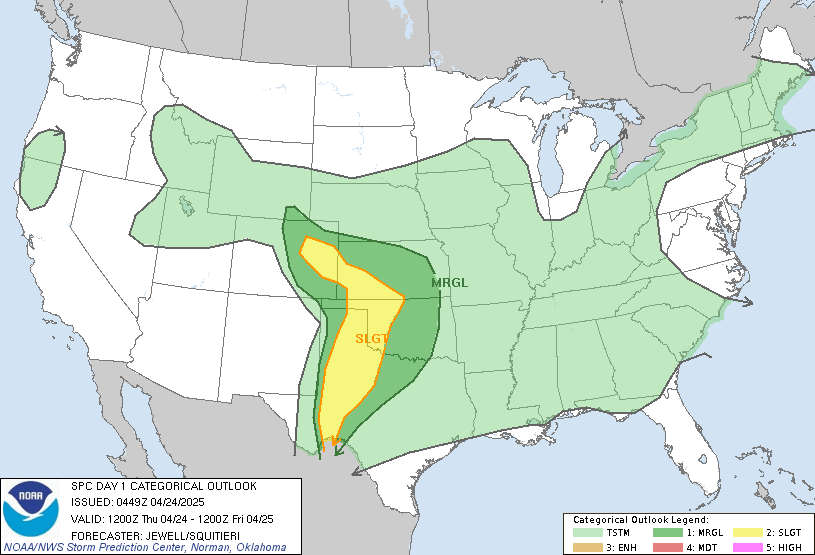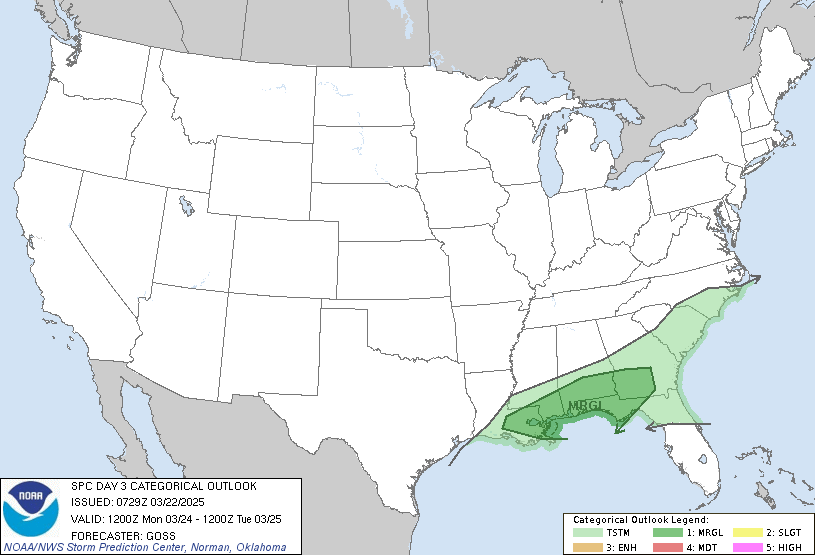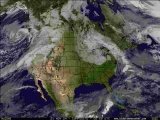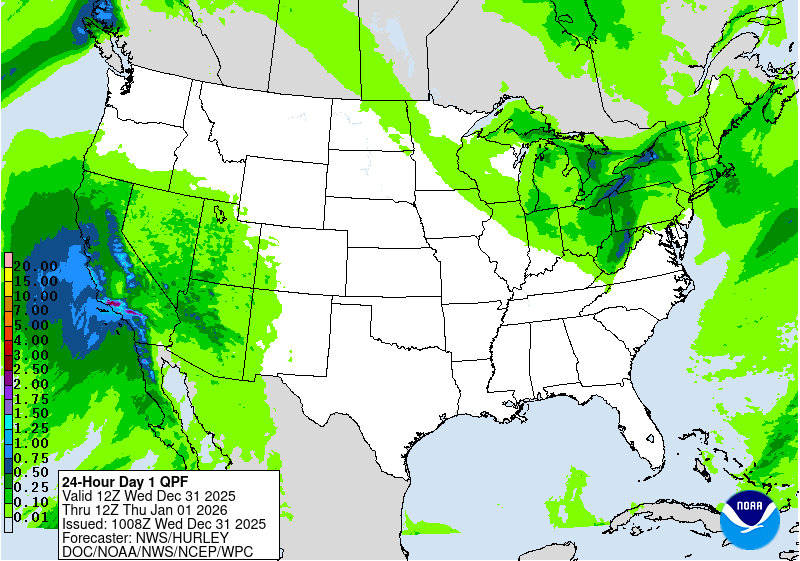No watches are valid as of Tue Jul 15 19:46:01 UTC 2025.No Mesoscale Discussions are in effect as of Tue Jul 15 19:46:01 UTC 2025.SPC 1630Z Day 1 Outlook

Day 1 Convective Outlook
NWS Storm Prediction Center Norman OK
1121 AM CDT Tue Jul 15 2025
Valid 151630Z - 161200Z
...THERE IS AN ENHANCED RISK OF SEVERE THUNDERSTORMS FOR CENTRAL
NEBRASKA...
...THERE IS A SLIGHT RISK OF SEVERE THUNDERSTORMS SURROUNDING THE
SLIGHT RISK INTO THE UPPER MIDWEST...FOR NORTHERN AND EASTERN
WYOMING...AND NORTHERN UTAH AND SURROUNDING VICINITY...
...SUMMARY...
Scattered severe gusts (some 75+ mph) and large hail are probable
across parts of Nebraska late this afternoon and evening. Scattered
severe gusts are also possible from the Upper Midwest to Utah and
Wyoming this afternoon to mid-evening.
...Northern/Central Plains to the Upper Midwest...
Primary focus for thunderstorms will be a slowly sagging,
southward-moving cold front across the Upper Midwest and a couple
mid-level perturbations moving east across the north-central states.
Radar imagery shows a convectively augment disturbance moving east
across northern SD and water-vapor imagery shows shortwave trough
moving east across southeast WY. Both mid-level features will
likely prove instrumental in storm coverage and the risk for severe
activity later today.
Despite stronger mid-level westerly flow relegated north of the 48th
parallel, strong heating of a moist airmass will result in a very
unstable boundary layer by mid afternoon from the Upper Midwest
southwestward into the NE Sandhills. Storms will probably develop
from eastern SD and into MN this afternoon near the front and ahead
of the SD mid-level feature. Sufficient instability and
effective bulk shear should be present along/ahead of the front to
support organized convection, including some supercells. Large hail
will be possible with the initially semi-discrete thunderstorms,
before a rapid transition to a cluster/linear mode increases the
threat for severe/damaging winds. This activity should quickly
weaken by late evening as it encounters a less unstable airmass with
eastward extent across the upper Great Lakes.
A somewhat separate area of thunderstorms should initiate
along/south of the front across parts of southern SD into NE by late
afternoon/early evening. Greater instability will likely be present
across this region compared to locations farther north, but
deep-layer shear should be more modest (around 25-30 kt). Still,
some large hail may occur initially given the presence of steep
mid-level lapse rates. The threat for scattered to numerous
severe/damaging winds is expected to increase through the evening
across central NE as an intense bowing cluster develops and spreads
southeastward. Isolated significant gusts of 75+ mph appear possible
given the rather favorable thermodynamic environment.
...Great Basin into Wyoming...
The only change for this portion of the region is to increase
severe-wind probabilities across northern UT and surrounding states.
The southern fringe of stronger mid-level westerlies was sampled by
the 12 UTC Salt Lake City raob. With the approach of the upstream
northern Rockies disturbance glancing the region later today,
short-term model guidance (e.g., HREF members, time-lagged HRRR) is
consistent in showing small clusters of storms moving east from
northeast NV/northwest UT eastward into northern UT/southeast ID/far
southwest WY. Inverted-V profiles will strongly favor evaporative
cooling with the more rain-laden cores. Scattered severe gusts are
possible with the more intense downbursts through early evening.
Farther east, the closer proximity to the upper trough digging
southeastward over the northern Rockies will promote scattered
storms across northern into eastern WY this afternoon and evening.
An organized cluster may evolve given 25-35 kt of deep-layer shear,
while posing a threat for mainly severe/damaging winds given the
presence of steepened low/mid-level lapse rates. Isolated large hail
may also occur.
...Arizona...
Modest mid-level east-northeasterlies will be present today across
parts of AZ on the southern periphery of a mid-level anticyclone
over the Southwest. Scattered thunderstorms should once again
develop this afternoon over the higher terrain of southeast AZ and
southwest NM. With very steep low/mid-level lapse rates expected
with ample daytime heating, this activity may pose an isolated
threat for severe winds as it spreads into the lower elevations of
southern AZ through the evening.
..Smith/Jirak.. 07/15/2025
SPC 1730Z Day 2 Outlook

Day 2 Convective Outlook
NWS Storm Prediction Center Norman OK
1232 PM CDT Tue Jul 15 2025
Valid 161200Z - 171200Z
...THERE IS A SLIGHT RISK OF SEVERE THUNDERSTORMS ACROSS THE FRONT
RANGE AND THE WESTERN GREAT LAKES REGION...
...SUMMARY...
Scattered strong to severe thunderstorms are possible Wednesday
afternoon and evening from parts of the central High Plains to the
Great Lakes.
...Front Range and High Plains...
A shortwave trough over the northern Rockies will intensify as it
moves eastward across the central US Wednesday. A cold front across
the Front Range and High Plains will continue to sag slowly
southward as surface moisture deepens behind it. Within the broad up
slope flow regime, scattered storm development is expected across
the higher terrain of the central Rockies and High Plains by early
afternoon Wednesday. Enhanced mid-level flow will support initial
supercells capable of hail and isolated damaging gusts. Local
terrain effects and enhanced low-level shear near the front may also
allow for a tornado or two. Scattered severe storms expand in
coverage across the I-25 corridor through the afternoon before
moving eastward into the plains through the evening.
How far east the severe threat will extend remains uncertain as
cooler temperatures and lingering inhibition are likely to be in
place behind the front. Should sufficient upscale growth take place,
an MCS may develop and merge with additional convection farther east
before continuing south/southeastward across the central Plains
overnight. This would support a continued risk for at least isolated
damaging gusts.
...Central Plains...
As the cold front continues to move southward across the central
Plains, lingering inhibition and forcing for ascent displaced to the
north should limit convective development along the front through
much of the day However, warm surface temperatures and 60s-70s F
surface dewpoints will support large buoyancy along the front. As a
30-40 kt low-level jet increases into the evening, storm development
is expected with increasing low-level warm air advection. Isolated
damaging gust are possible.
...Great Lakes...
A convectively augmented shortwave trough over the central Plains
will quickly move eastward along the sagging cold front. Ascent from
this feature will aid in developing a wave cyclone along the front,
enhancing the low-level flow field across parts of WI and northern
IL. An ongoing arc of storms near the surface low should gradually
re-intensify through the morning and into the early afternoon.
Moderate MLCAPE and strengthening flow aloft will support a mix of
cells and clusters. The primary risk is expected to be damaging
gusts, though enlarged low-level hodographs and 100-200 J/kg of
MLCAPE below 3km AGL may support some tornado risk with the more
cellular elements. With time gradual upscale growth into a more
linear structure is expected near the western shores of Lake
Michigan with a continued risk for damaging gusts.
To the east, strong heating of a very humid air mass is expected
across Lower Michigan through the afternoon. Scattered to widespread
storms are likely along the typical lake breeze fronts. Vertical
shear will be weaker through the afternoon, though at least some
enhancement of the flow field could support isolated damaging gusts
with scattered to numerous storms expected.
There is some potential for a more organized line/cluster of storms
on the western side of the lake to move eastward across Lake
Michigan late in the evening and through the overnight hours.
Stronger flow aloft near the shortwave trough could support damaging
gust and brief tornado potential across parts of northern Lower
Michigan overnight. Higher severe probabilities could be needed if
confidence in this convective scenario increases in future outlooks.
...Upper OH valley...
Widespread thunderstorms are expected across the region in response
to a shortwave impulse. Modest instability is forecast amid a very
moist airmass. While vertical shear will remain fairly limited, some
slight enhancement near the upper trough could support a few
longer-lived storm clusters. Isolated strong gusts/wet microbursts
could occur, with the more intense storms.
...Northern Gulf Coast...
Scattered to numerous thunderstorms associated with Invest 93L will
occasionally move onshore across the northern/central Gulf Coast
Wednesday and Wednesday night. Enhancement of low and mid-level
easterly shear north of the weak surface circulation may support a
few longer-lived cells near the coast. Sporadic damaging gusts and
perhaps a brief tornado are possible, though confidence in this
convective scenario is very low.
..Lyons.. 07/15/2025
SPC 1930Z Day 3 Outlook

Day 3 Convective Outlook
NWS Storm Prediction Center Norman OK
0224 PM CDT Tue Jul 15 2025
Valid 171200Z - 181200Z
...THERE IS A MARGINAL RISK OF SEVERE THUNDERSTORMS FROM THE OHIO
VALLEY TO THE NORTHEAST STATES...
...SUMMARY...
Isolated damaging gusts are possible over parts of the Northeast
Thursday.
...Northeast and upper OH Valley...
Shortwave troughing over the eastern Great Lakes will gradually
merge with broader cyclonic flow over the Northeast and eastern
Canada Thursday. A surface low will steadily deepen as it shifts
eastward with the upper trough. A cold front trailing the low will
serve as a focus for thunderstorm development through the afternoon
from the OH valley to the Mid Atlantic and Northeast. Moderate
buoyancy and strengthening flow aloft will overlap and could support
scattered thunderstorms capable of damaging gusts ahead of the
front. A large disparity exists among forecast guidance with regards
to the position of the cold front, strength of the surface low and
any potential MCVs from prior day's convection. While confidence in
the overall evolution is somewhat low, the broader environment still
appears favorable enough to support some severe risk.
...Mid MS Valley and southern Plains...
Scattered storms are expected along the cold front as it moves
southward across the Mid South and the Southern Plains. Stronger
vertical shear should largely lag behind the front especially with
southward extent. A few stronger storm clusters are possible along
the front where large buoyancy could support sporadic damaging
gusts. However, confidence in the frontal timing and convective
evolution is very low, precluding the addition of severe
probabilities for now.
..Lyons.. 07/15/2025
|
























































































